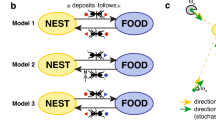Abstract
A stochastic cellular automata model for the population dynamics of the army antEciton burchelli on Barro Colorado Island in Panama is set up. It is simulated on the computer and shown to give good agreement with biological data. It is analysed using two approximations akin to the mean field approximation in statistical mechanics, and good agreement with the simulations is obtained. Finally, the role of distance between successive statary phase bivouacs is discussed with regard to the rate of colony growth.
There are two aspects of the biological system studied here that make it of general importance. First, the population is structured, since the size of each colony of army ants is crucial. Second, the spatial behaviour of the population, as in many others, is not diffusion-like, although it is random. This has implications for the kind of model that is chosen.
Similar content being viewed by others
References
Britton, N. F., L. W. Partridge, and N. R. Franks. 1996. A model of survival times for population of army ants. Submitted toBull. Math. Biol.
Caswell, H. and R. J. Etter. 1993. Ecological interactions in patchy environments: from patch-occupancy models to cellular automata. InPatch Dynamics. Lecture Notes in Biomathematics, S. A. Levin, T. M. Powell, and J. H. Steele (Eds), Vol. 96, pp. 93–109. New York: Springer.
Caughley, G. 1994. Directions in conservation biology.J. Anim. Ecol. 63, 215–244.
Czaran, T. and S. Bartha. 1992. Spatiotemporal dynamic models of plant populations and communities.Trends Ecol. Evol. 7, 38–42.
Durrett, R. 1992. Stochastic models of growth and competition. InPatch Dynamics. Lecture Notes in Biomathematics, S. A. Levin, T. Powell, and J. Steele (Eds), Vol. 96, pp. 176–183. New York: Springer.
Durrett, R. and S. A. Levin. 1994. Stochastic spatial models: A user's guide to ecological applications.Phil. Trans. Roy. Soc. London Ser B,343, 329–350.
Ermentrout, G. B. and L. Edelstein-Keshet. 1993. Cellular automata approaches to biological modelling.J. Theor. Biol. 160, 97–133.
Fisch, R., J. Gravner, and D. Griffeath. 1991. Threshold range scaling of excitable cellular automata.Statist. Comp. 1, 23–29.
Franks, N. R. 1992a. Ecology and population regulation in the army antEciton burchelli. InThe Ecology of a Tropical Forest: Seasonal Rhythms and Long-Term Changes, E. G. Leigh, A. S. Rand, and D. M. Windsor (eds.), pp. 389–395. Washington, DC: Smithsonian Institution Press.
Franks, N. R. 1982b. A new method for censusing animal populations: the number ofEciton burchelli army ant colonies on Barro Colorado Island, Panama.Oecologia Berlin 52, 266–268.
Franks, N. R. 1982c. Social insects in the aftermath of swarm raids of the army antEciton burchelli. InBiology of Social Insects. Proceedings of the 9th International Congress of the International Congress of the International Union for the Study of Social Insects, M. D. Breed, C. D. Michener, and H. E. Evans (Eds.), pp. 275–279. Boulder, CO: Westview Press.
Franks, N. R. 1985. Reproduction, foraging efficiency and worker polymorphism in army ants. InExperimental Behavioral Ecology. Fortschritte der Zoologie, M. Lindauer and B. Hölldobler (Eds.), Vol. 31, pp. 91–107. Stuttgart: G. Fischer.
Franks, N. R. 1989. Army ants: a collective intelligence.Am. Scientist 77, 139–145.
Franks, N. R. and W. H. Bossert. 1983. The influence of swarm raiding army ants on the patchiness and diversity of a tropical leaf litter ant community. In E. L. Sutton,The Tropical Rain Forest: Ecology and Management, E. L. Sutton, A. C. Chadwick, and T. C. Whitmore (eds), pp. 151–163. Oxford: Blackwell.
Franks, N. R. and C. R. Fletcher. 1983. Spatial patterns in army ant foraging and migration:Eciton burchelli on Barro Colorado Island, Panama.Behav. Ecol. Sociobiol. 12, 261–270.
Hassell, M. P., H. N. Comins, and R. M. May 1991. Spatial structure and chaos in insect population dynamics.Nature London 353, 255–258.
Onsager, L. 1944. Crystal statistics. I. A two-dimensional model with order-disorder transitions.Phys. Rev. 65, 117.
Otis, G. W., C. E. Santana, D. L. Crawford, and M. L. Higgins. 1986. The effect of foraging army ants on leaf-litter arthropods.Biotropica 18, 56–61.
Partridge, L. W., 1994. Facets of the ecology, behaviour and evolution of ants. PhD thesis, University of Bath.
Rand, D. S. and H. B. Wilson. 1995. Using spatio-temporal chaos and intermediate-scale determinism to quantify spatially extended ecosystems.Proc. Roy. Soc. London Ser. B,259, 111–117.
Ray, T. S. and C. C. Andrews. 1980. Antbutterflies: butterflies that follow army ants to feed on antbrid droppings.Science 210, 1147–1148.
Rettenmeyer, C. W. 1963. Behavioral studies of army ants.Kansas Univ. Sci. Bull. 44, 281–465.
Schneirla, T. C. 1971. Army ants. InA Study in Social Organization, H. R. Topoff (Ed.), San Francisco: W. H. Freeman.
Simberloff, D. 1988. The contribution of population and community biology to conservation science.Ann. Rev. Ecol. Systematics 19, 473–511.
Willis, E. O. 1967. The behavior of bicolored antbirds.Univ. Calif. Publ. Zool. 79, 1–127.
Author information
Authors and Affiliations
Rights and permissions
About this article
Cite this article
Britton, N.F., Partridge, L.W. & Franks, N.R. A mathematical model for the population dynamics of army ants. Bltn Mathcal Biology 58, 471–492 (1996). https://doi.org/10.1007/BF02460593
Received:
Issue Date:
DOI: https://doi.org/10.1007/BF02460593




